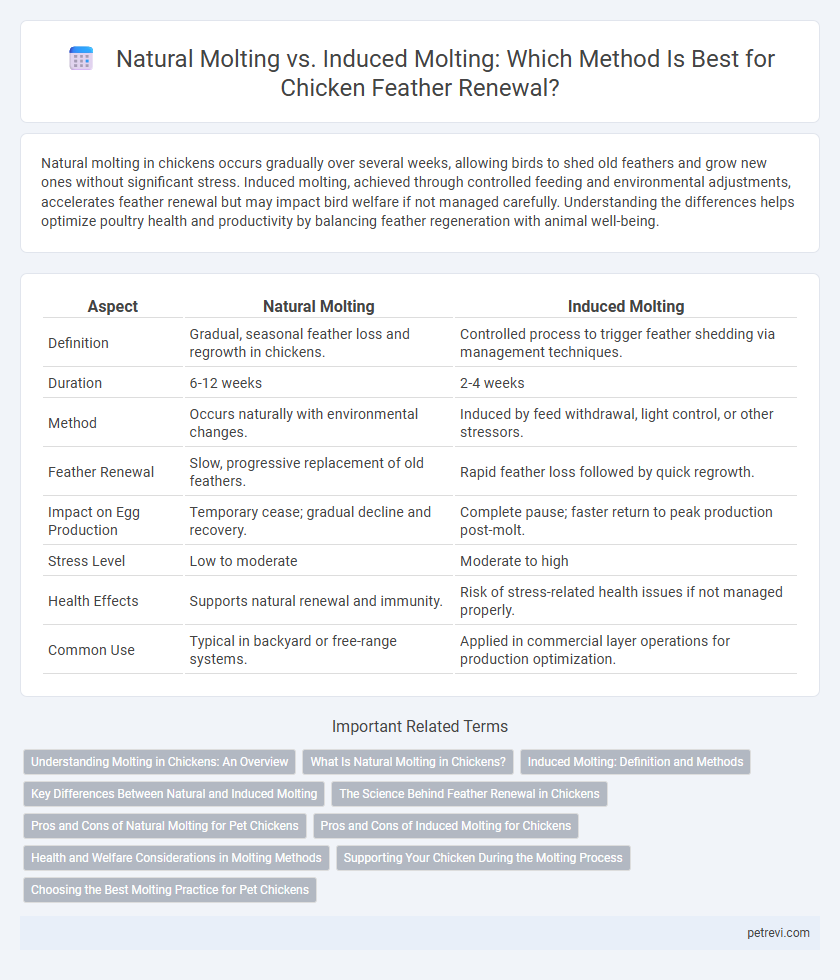Natural molting in chickens occurs gradually over several weeks, allowing birds to shed old feathers and grow new ones without significant stress. Induced molting, achieved through controlled feeding and environmental adjustments, accelerates feather renewal but may impact bird welfare if not managed carefully. Understanding the differences helps optimize poultry health and productivity by balancing feather regeneration with animal well-being.
Table of Comparison
| Aspect | Natural Molting | Induced Molting |
|---|---|---|
| Definition | Gradual, seasonal feather loss and regrowth in chickens. | Controlled process to trigger feather shedding via management techniques. |
| Duration | 6-12 weeks | 2-4 weeks |
| Method | Occurs naturally with environmental changes. | Induced by feed withdrawal, light control, or other stressors. |
| Feather Renewal | Slow, progressive replacement of old feathers. | Rapid feather loss followed by quick regrowth. |
| Impact on Egg Production | Temporary cease; gradual decline and recovery. | Complete pause; faster return to peak production post-molt. |
| Stress Level | Low to moderate | Moderate to high |
| Health Effects | Supports natural renewal and immunity. | Risk of stress-related health issues if not managed properly. |
| Common Use | Typical in backyard or free-range systems. | Applied in commercial layer operations for production optimization. |
Understanding Molting in Chickens: An Overview
Molting in chickens is a natural process where birds shed and regrow feathers to maintain optimal insulation and flight ability, typically occurring annually as daylight hours decrease. Induced molting, often achieved through controlled feeding and environmental adjustments, accelerates feather renewal and resets the laying cycle to improve egg production efficiency. Understanding these methods helps poultry farmers balance bird welfare with productivity goals, ensuring healthier flocks and sustained egg quality.
What Is Natural Molting in Chickens?
Natural molting in chickens is a physiological process where birds shed old feathers and grow new ones, typically occurring annually. This feather renewal supports improved insulation, flight, and overall health without external intervention. During natural molting, chickens may reduce egg production temporarily as the body reallocates energy towards feather growth and regeneration.
Induced Molting: Definition and Methods
Induced molting is a management practice in poultry farming designed to accelerate feather renewal and rejuvenate egg production by manipulating environmental and nutritional factors. Common methods include feed withdrawal, reduced lighting, and dietary modifications such as low protein or high zinc diets to stimulate stress responses that trigger molting. This controlled approach allows producers to synchronize flock molting, improving egg quality and extending the productive lifespan of layers compared to natural molting.
Key Differences Between Natural and Induced Molting
Natural molting in chickens occurs gradually over several weeks, allowing birds to shed and regrow feathers in response to seasonal changes without external intervention. Induced molting, triggered through controlled environmental and nutritional adjustments, accelerates feather renewal to enhance egg production cycles. Key differences include the duration and stress levels experienced by chickens, with natural molting promoting smoother feather replacement and induced molting often leading to temporary declines in bird welfare and productivity.
The Science Behind Feather Renewal in Chickens
Feather renewal in chickens occurs through natural molting, a hormonally regulated process triggered by changes in daylight and environmental factors, leading to the shedding and regrowth of feathers for optimal insulation and flight. Induced molting, often achieved through controlled feed restriction or light manipulation, accelerates this cycle by stimulating the hypothalamic-pituitary-gonadal axis to conserve energy for feather regeneration and egg production restart. Understanding the endocrine responses and nutritional requirements during both natural and induced molting is crucial for optimizing poultry health and productivity.
Pros and Cons of Natural Molting for Pet Chickens
Natural molting in pet chickens promotes gradual feather renewal, supporting overall health by allowing the bird's body to recover without added stress. This process ensures a more balanced nutrient allocation, minimizing disruptions in egg production and maintaining a stable environment for the bird's immune system. However, natural molting takes longer, which may lead to extended periods of reduced egg laying and vulnerability to cold weather due to thinner feather coverage.
Pros and Cons of Induced Molting for Chickens
Induced molting in chickens accelerates feather renewal and improves egg production by manipulating light, feed, and water intake, resulting in uniform molt cycles and better flock management. However, this method can cause significant stress, weaken immunity, and increase susceptibility to disease, posing animal welfare concerns. While induced molting enhances production efficiency, it must balance health risks and ethical considerations for sustainable poultry farming.
Health and Welfare Considerations in Molting Methods
Natural molting in chickens promotes gradual feather renewal, supporting immune function and minimizing stress, whereas induced molting, often achieved through feed restriction or environmental manipulation, can elevate corticosterone levels and negatively impact bird welfare. Health considerations emphasize avoiding severe nutritional deprivation to prevent compromised gut integrity and increased susceptibility to disease during induced molting. Welfare-focused molting practices prioritize maintaining adequate nutrition, hydration, and minimizing environmental stressors to ensure optimal recovery and feather regrowth.
Supporting Your Chicken During the Molting Process
Supporting your chicken during natural molting requires providing a nutrient-rich diet high in protein and essential vitamins like biotin and vitamin E to promote healthy feather regrowth. In induced molting, carefully managing stress through controlled fasting and environmental adjustments helps trigger feather shedding while ensuring recovery with supplemental nutrition and hydration. Maintaining clean, comfortable housing reduces the risk of infections and supports overall well-being throughout the molting cycle.
Choosing the Best Molting Practice for Pet Chickens
Natural molting in pet chickens allows for gradual feather renewal driven by seasonal changes, supporting overall bird health and minimizing stress. Induced molting, often triggered by controlled fasting or light manipulation, accelerates feather regrowth but can compromise immunity and welfare if not carefully managed. Selecting the best molting practice requires balancing the chicken's environment and health needs, favoring natural molting for pet chickens to ensure gentle, sustainable feather replacement.
Natural Molting vs Induced Molting for Chicken Feather Renewal Infographic

 petrevi.com
petrevi.com